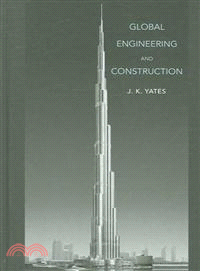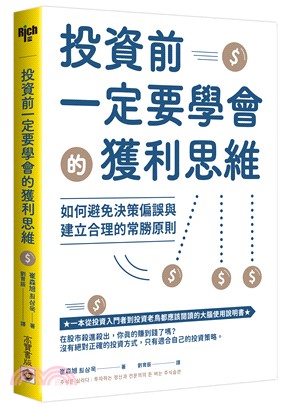Global Engineering And Construction
- ISBN13:9780471743828
- 出版社:John Wiley & Sons Inc
- 作者:Yates
- 裝訂/頁數:精裝/400頁
- 出版日:2006/10/20
商品簡介
The first book written for operations-level engineers, constructors, and students, Global Engineering and Construction is an essential manual for navigating the confusing world of engineering and construction in the global arena and for working on multinational teams. From project management to finance, global construction to alliances, international standards to competitiveness, this book contains country- and region-specific information on cultural issues, legal systems, bid estimates, scheduling, business practices, productivity improvement, and tips for successfully working on and managing global projects. This book also provides a useful glossary and numerous case studies illustrating practices in the real world.
Global Engineering and Construction features the latest coverage on such topics as:
- Project management
- Engineering design
- Designing for terrorism
- Kidnapping protection
- Construction failures
- Preparing to work globally
- Safety Issues
- Legal Issues
- Technical and quality standards
- Environmental issues
- Productivity improvement
- Planning and engineering delays and mitigation strategies
- Concepts of culture and global issues
- Global competitiveness
- Global engineering and construction alliances
- Global financing techniques
- Country-specific information
作者簡介
目次
About the Author.
Acknowledgments.
Chapter 1: Introduction.
1.1 Global Engineers and Constructors.
1.2 Engineering and Construction Global Ambassadors.
1.3 Global Risks to Engineers and Constructors.
1.4 Organization of This Book.
1.5 Summary.
Chapter 2: The Concept of Culture and Global Issues Important to Engineers and Constructors.
2.1 Introduction.
2.2 Sources of Information.
2.3 Language and Translation Considerations for Design.
2.4 Design Criteria for Different Cultures.
2.5 Cultural Issues That Affect Engineers and Constructors.
2.6 Suggestions for Adapting to Foreign Cultures.
2.7 Economics.
2.8 Politics.
2.9 Summary.
Discussion Questions.
References.
Chapter 3: Managing Global Engineering and Construction Projects.
3.1 Introduction.
3.2 Management Functions and Project Objectives.
3.3 Three-Dimensional Project-Objective Model (POM).
3.4 Hierarchy of Objectives.
3.5 Determining Objectives.
3.6 Managing Projects in Foreign Countries.
3.7 Characteristics of Global Project Managers.
3.8 Calendars and Time Considerations.
3.9 Technology Considerations.
3.10 Estimating.
3.11 Scheduling.
3.12 Permits and Codes.
3.13 Construction Safety Issues.
3.14 Construction Failures and Investigation Techniques.
3.15 Case Study: Indonesia.
3.16 Summary.
Discussion Questions.
References.
Chapter 4: Global Competitiveness in the Engineering and Construction Industry.
4.1 Introduction.
4.2 Definition of Competitiveness.
4.3 Competitiveness Issues.
4.4 Competitive Forces in the 1980s.
4.5 Changes in the E&C Industry Structure in the 1990s.
4.6 Forces Driving Competition in the Twenty-First Century.
4.7 Changes in the E&C Industry in the Twenty-First Century.
4.8 The Changing Nature of E&C Industry Competition.
4.9 Summary.
Discussion Questions.
References.
Chapter 5: Global Engineering and Construction Alliances.
5.1 Introduction.
5.2 Multinational Contractors.
5.3 The Global Dimension.
5.4 Risks in Global Investment.
5.5 Project Financing.
5.6 Privatization.
5.7 Build-Own-Transfer (BOT).
5.8 Joint Ventures and Partnerships.
5.9 Summary.
Discussion Questions.
References.
Chapter 6: Global Construction Financial Techniques.
6.1 Introduction.
6.2 Countertrade.
6.3 Cofinancing with the World Bank.
6.4 Project Financing.
6.5 Global Payment Methods.
6.6 Bills of Lading, Commercial Invoices, and Consular Invoices.
6.7 The U.S. Export-Import Bank and Private Export Funding Agencies.
6.8 Summary.
Discussion Questions.
References.
Chapter 7: Global Legal Issues for Engineers and Constructors.
7.1 Introduction.
7.2 International Conventions.
7.3 Regional Legal Issues.
7.4 International Contracts.
7.5 Claims and Change Orders.
7.6 Dispute-Resolution Techniques.
7.7 International Arbitration.
7.8 Anticorruption Legislation.
7.9 Kidnapping and Ransom Insurance.
7.10 Changing Governments.
7.11 Liability Issues.
7.12 Summary.
Discussion Questions.
References.
Chapter 8: International Engineering and Construction Standards.
8.1 Introduction.
8.2 Definition of Standards.
8.3 Technical Standards.
8.4 Consensus Standards.
8.5 Government Standards.
8.6 Nongovernment Standards.
8.7 International Standards.
8.8 International Organization for Standardization (ISO).
8.9 The Development Process for Standards.
8.10 International Technical Standards.
8.11 ISO 9000 Quality Management System Standards.
8.12 ISO 14000 Environmental Management Series of Standards.
8.13 ISO 4217 Global Currency Codes and Names.
8.14 The ISO 9000 and 14000 Registration Process.
8.15 Advantages and Disadvantages of International Standards.
8.16 Summary.
Discussion Questions.
References.
Chapter 9: Global Environmental Issues of Concern to Engineers and Constructors.
9.1 Introduction.
9.2 The United Nations Framework Convention on Climate Change (UNFCCC).
9.3 Effects of the Kyoto Protocol on the Engineering and Construction Industry.
9.4 Global Environmental Management.
9.5 Country-Specific Environmental Issues.
9.6 Summary.
Discussion Questions.
References.
Chapter 10: Global Productivity Issues on Construction Projects.
10.1 Introduction.
10.2 International Comparisons of Labor Productivity.
10.3 Case Study: Worker Productivity in Nigeria and the United States.
10.4 Labor Productivity Variations.
10.5 Labor Productivity Factors.
10.6 Factors that Affect Productivity on Global Projects.
10.7 Summary.
Discussion Questions.
References.
Chapter 11: Global Planning and Construction Delays.
11.1 Introduction.
11.2 Accounting for Global Variations in Construction.
11.3 Bribery Policies.
11.4 Categories of Global Nontechnical Delays.
11.5 Global Engineering and Construction Delays.
11.6 Indicators of Project Delays.
11.7 Global Project Planning Delays.
11.8 Summary.
Discussion Questions.
References.
Chapter 12: Global Terrorism: Kidnapping and Design Considerations.
12.1 Introduction.
12.2 Definitions of Terrorism.
12.3 Terrorist Behavior.
12.4 Financial Support for Terrorism.
12.5 Terrorist Strategies and Profiles.
12.6 Kidnapping Issues.
12.7 Preventing Terrorism.
12.8 Building Protection.
12.9 Web Sites with Additional Information on Terrorism.
12.10 Summary.
Discussion Questions.
References.
Chapter 13: Preparing Engineers and Constructors to Work Globally.
13.1 Introduction.
13.2 Definition of Culture.
13.3 Cultural Differences.
13.4 Language Differences.
13.5 Technology Transfer.
13.6 The Importance of Cross-Cultural Training Programs.
13.7 Developing Cross-Cultural Training Programs.
13.8 What to Know Before Working Overseas.
13.9 Language Training.
13.10 Educational Considerations.
13.11 Entertainment Issues.
13.12 Short- and Long-Term Housing.
13.13 Food and Water Supplies.
13.14 Transportation Issues.
13.15 Foreign Work Environments.
13.16 Prejudice.
13.17 Culture Shock.
13.18 Going Native.
13.19 Avoiding Foreign Jails.
13.20 Summary.
Discussion Questions.
References.
Chapter 14: Country-Specific Information.
14.1 Introduction.
14.2 Africa.
14.3 Asia.
14.4 Eastern Europe.
14.5 The Near and Middle East.
14.6 North America.
14.7 Oceana.
14.8 South America.
14.9 Southeast Asia.
14.10 Western Europe.
14.11 Summary.
References.
Appendix A Glossary.
Appendix B Case Study: Managing Projects in Rural Developing Countries.
References.
Appendix C Definitions of Religions.
Index.
主題書展
更多主題書展
更多書展本週66折
您曾經瀏覽過的商品
購物須知
外文書商品之書封,為出版社提供之樣本。實際出貨商品,以出版社所提供之現有版本為主。部份書籍,因出版社供應狀況特殊,匯率將依實際狀況做調整。
無庫存之商品,在您完成訂單程序之後,將以空運的方式為你下單調貨。為了縮短等待的時間,建議您將外文書與其他商品分開下單,以獲得最快的取貨速度,平均調貨時間為1~2個月。
為了保護您的權益,「三民網路書店」提供會員七日商品鑑賞期(收到商品為起始日)。
若要辦理退貨,請在商品鑑賞期內寄回,且商品必須是全新狀態與完整包裝(商品、附件、發票、隨貨贈品等)否則恕不接受退貨。
























